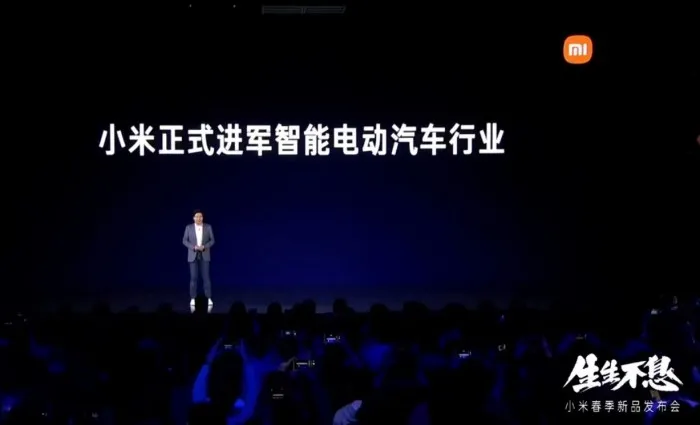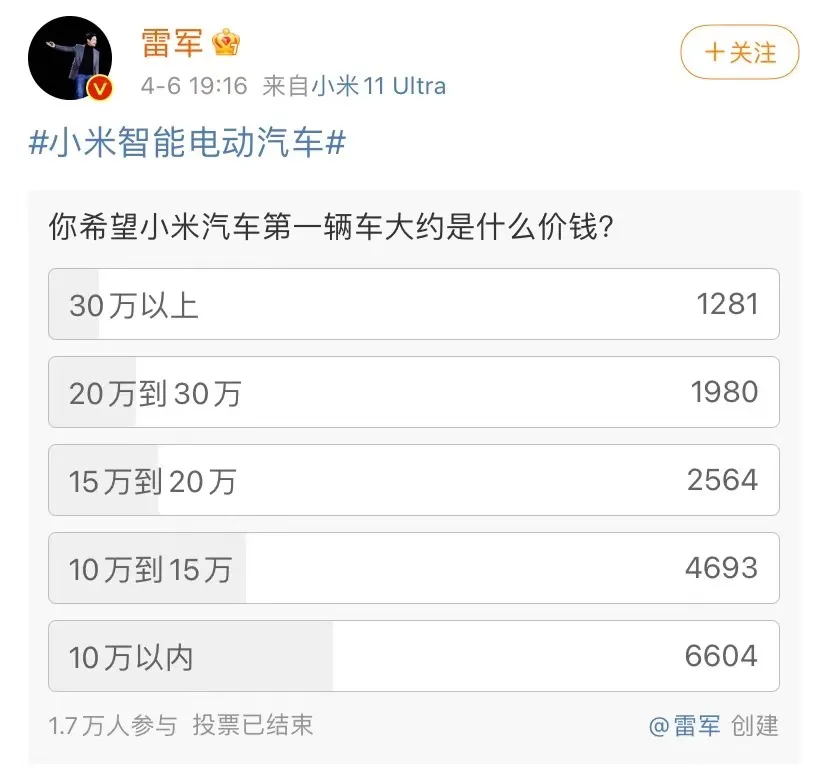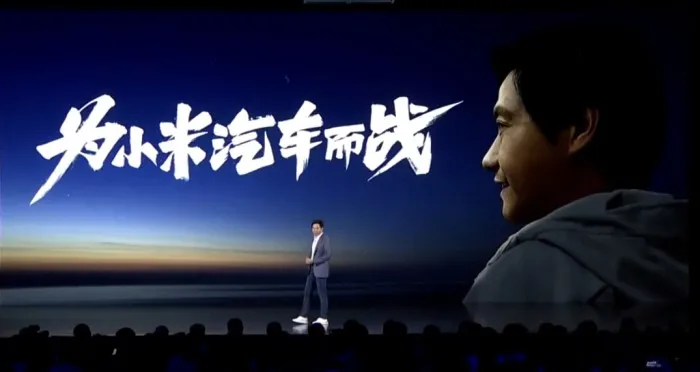Author: Michelin
Ever since Xiaomi announced last week that it will be entering the car manufacturing industry, there have been countless speculations on “How will Xiaomi produce cars?”, “What would be the features of Xiaomi’s electric car?”, “What would be the price of Xiaomi’s electric car?”.
During the live stream that followed after the Mi Fan Festival tonight, Xiaomi’s Chairman and CEO, Lei Jun, revealed some information about Xiaomi’s car. Through the information he revealed, let’s examine whether Xiaomi’s car meets our expectations.

Will the price range be between ¥100,000 and ¥300,000? A sedan or an SUV?
Before the live stream, Lei Jun posted three polls on Weibo. The content of these polls were what everyone was most concerned about:
- Do you think Xiaomi should use the “Xiaomi” brand name for its electric car?
- What do you think will be the price range of Xiaomi’s first car?
- What type of car do you think Xiaomi’s first car should be?

Based on the results of these three polls, we can get an idea of how Xiaomi’s electric car might look like:
More than 60% of respondents believe that Xiaomi should stick to the “Xiaomi” brand name, which already has a good reputation. More than 80% of people believe that Xiaomi’s first car will either be an SUV or a sedan, which highlights the focus on car models.
As for the price range, although more people have chosen the range below ¥ 100,000, 2/3 of the respondents still chose the range above ¥100,000, and Lei Jun emphasized that 8% of the respondents chose the range above ¥300,000. Therefore, it seems that Xiaomi has positioned its first car in the mid-high end market.
What kind of car is Xiaomi planning on making?
In this live stream, although Xiaomi revealed information about its car, it was still quite abstract. Lei Jun described Xiaomi’s car as its “first battle is its last”, indicating the importance of Xiaomi’s first car.
Unlike smartphones, where there is room for brands to start over, cars have a complex supply chain and strict demand for industrialization, leaving no opportunity for brands to start over. Xiaomi’s first car represents its style and attitude towards car manufacturing. Therefore, let’s try to visualize Xiaomi’s car in a bold way.
- Pricing is always the most important factor for consumers
Whether it is Xiaomi’s transition from a budget smartphone to a high-end smartphone or the survey result on car prices initiated by Lei Jun, it is obvious that Xiaomi’s electric car is not going to follow the “high performance-to-price ratio” strategy of its early smartphones.
With the development of China’s new energy industry, the supply chain has matured and improved substantially. We have recently seen the drop in battery prices as a result of the mature supply chain. Xiaomi’s electric car won’t be on the market for at least three years, which leaves enough room for Xiaomi to choose the price range.From the current pure electric vehicle market, there is no absolute leader in the 150,000-200,000 RMB price range. Currently, the electric vehicles in this price range are somewhat unsatisfactory in terms of performance and experience. It seems that an innovator is urgently needed. Therefore, we might as well narrow the price range a bit more, and the 150,000-200,000 RMB new energy vehicles may be the space for Xiaomi’s entry.
Being friends with users, the user experience may be the biggest selling point.
Although various brands are currently building intelligent cockpits, the intelligent experience that users really want cannot be solved by simply having more and larger screens inside the cockpit. Regarding what users want, Xiaomi, which has experience in making smartphones and smart homes, may understand more than car companies.
Just like what Lei Jun imagined in the live stream, if it is dangerous to sleep in a sealed car during summer, why doesn’t the car air conditioner install a fresh air system? In the dry winter in the north, why not install a humidifier in the car? Compared with the hidden champagne cabinet in high-end car rear seats, isn’t it more satisfying for ordinary users to directly have ice water in the summer?
These little details, which are things that Xiaomi who makes fresh air systems and humidifiers for their own homes would immediately think of. What Xiaomi wants to do in the cockpit experience may not be addition, but subtraction. From the experience of existing smart homes, remove unnecessary needs in the cockpit and truly grasp user pain points.
Therefore, although many people do not hold a positive view on Xiaomi, a smartphone manufacturer, entering the car manufacturing industry, we have to admit that Xiaomi’s huge user base in smartphones and experience in user-centric design from smartphones and smart home devices is their biggest advantage in entering the car manufacturing industry.
Can we build a car like building a smartphone?
While curious about Xiaomi’s car, we are even more curious about the new ways Xiaomi can bring to the automotive industry. Interacting with its fans and letting its fans vote for choosing product features are conventional operations in the field of consumer electronics, but these are not common in car manufacturing. Bringing smartphone manufacturing methods into car manufacturing may have its advantages, but it also faces significant challenges.
If people’s demand for traditional fossil fuel vehicles is driving experience and handling, then in the new energy vehicle era, more and more people are willing to pay for intelligence and electrification.
Therefore, in the current situation where the underlying hardware, electronic architecture, and chip platforms of electric vehicles have been completely renewed, the “new forces” no longer blindly focus on the “hardcore” technology but instead focus on software development. How to make the car system compatible with the ecosystem and the whole vehicle may be where Xiaomi can use its experience in developing phone systems.
However, if only software development ability is available, there is still a long way to go in car manufacturing. When facing a highly industrialized product like a car that has dozens or hundreds more components than a smartphone, a significant challenge for Xiaomi is how to build its own supply chain architecture. In today’s self-developing car industry, how Xiaomi can participate deeply in the self-development of key technologies rather than completely relying on suppliers is still a challenge to overcome.### Final Thoughts
Although the sneak peeks of Xiaomi’s car project have sparked our imagination, we can’t overlook the importance of building a supply chain and the underlying infrastructure that supports intelligent cockpits. Currently, we still don’t have the answers to these questions when it comes to Xiaomi. At least for now, we haven’t seen any movement from Xiaomi in terms of recruiting R&D personnel in the automotive industry. So, how is Xiaomi going to solve problems that cannot be outsourced to suppliers? When will Xiaomi officially put their plans into action?
Currently, Xiaomi seems to be making a lot of noise about their car project, but they’re also being cautious about making any big moves. We won’t know what surprises Xiaomi’s car project will bring until everything is finalized.
This article is a translation by ChatGPT of a Chinese report from 42HOW. If you have any questions about it, please email bd@42how.com.
